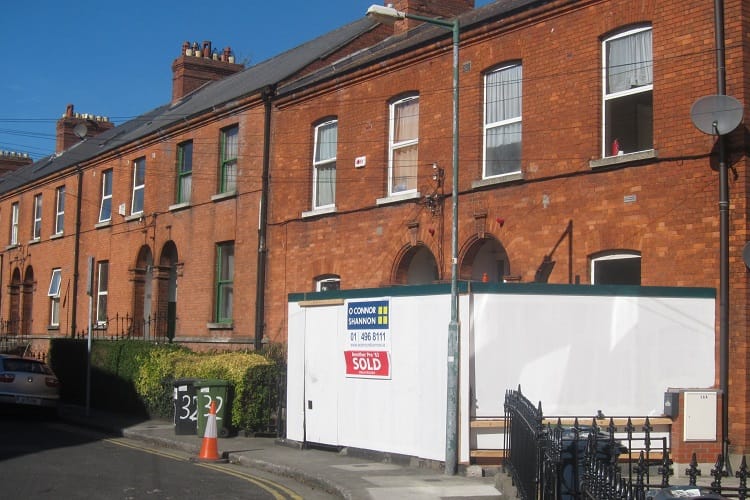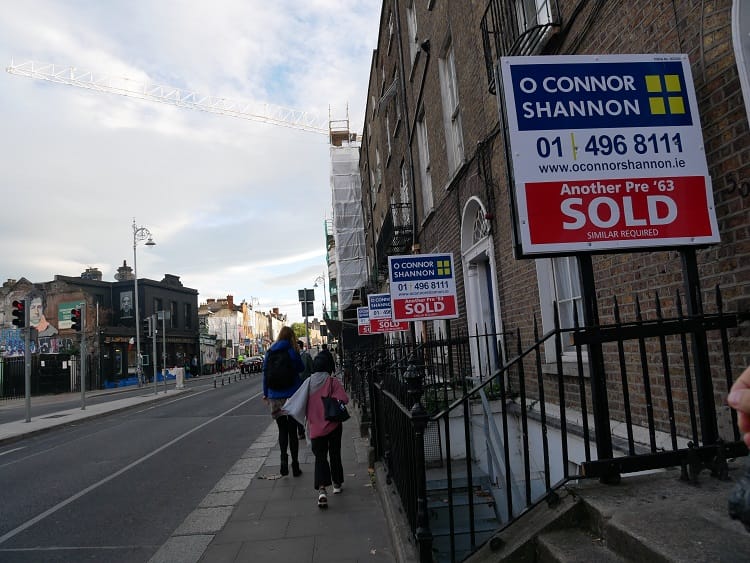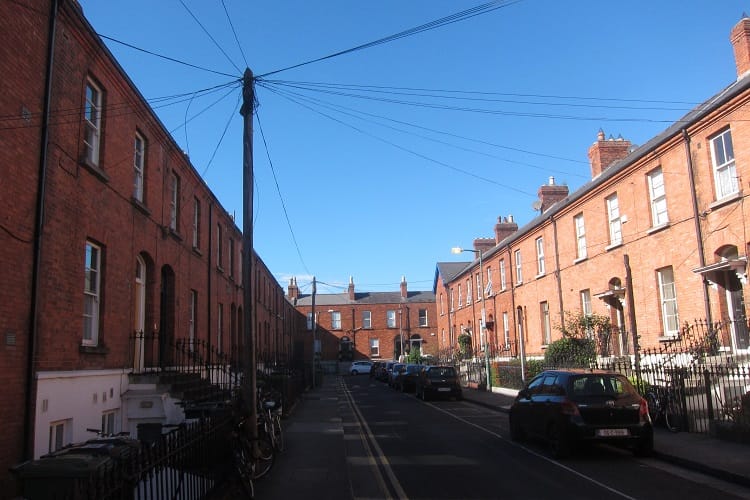What would become of the Civic Offices on Wood Quay if the council relocates?
After The Currency reported the idea of the council moving its HQ, councillors were talking about and thinking through the pros and cons and implications.
The little street, long a cluster of affordable homes hosting students, artists and hardworking families, seems to be in the process of a change that is transforming it into a different kind of neighbourhood.

Earlier this year, Felipe Kussik peeked through a few of the windows along Grove Park.
He was curious about the wave of renovations that seemed to be happening. Old fabric blinds were being stripped out and replaced with IKEA-looking ones. “They look good in pictures, I think,” he says.
Some apartments had beds suspended from the ceiling. But it was the size of the flats that struck him most. “They’re getting smaller. The flats are getting smaller,” he said, over coffee early on Monday morning at the Grove Road café.
Others on the road have noticed changes on the old red-brick street, too. “There’s just so much going on building-work wise this year,” says Cheree Broughton. “Like, I’m living here three years and I’ve never seen as much activity as I have the last few months.”
On Monday on Grove Park, there were new white blinds pulled down at number 8, and scaffolding on the house at the bend in the road at number 61, where several builders were at work.
Outside the impressive Kensington Lodge, the first house on the right as you enter Grove Park from the Rathmines Road there was a full skip, draped with a carpet. Further up, the grouting looked fresh at numbers 36 and 38.
Next door, boarding surrounds number 34, the scene of a fire last September in which a man died. It reads “O’Connor Shannon”. Similar boarding has appeared outside number 82.

Coleman Connor of O’Connor Shannon said it has helped with two sales on the street recently.
The little street, long a cluster of affordable homes hosting students, artists and hardworking families, seems to be in the process of a change that is transforming it into a different kind of neighbourhood.
Peter Dooley of the Dublin Renters’ Union, a tenants’ advocacy group active in Rathmines, says that there has been a wave of renovations and many residents are having to move out of the area.
“They’re being moved beyond their community and being replaced beyond their network,” he says.
Dooley says the Dublin Renters’ Union has dealt with some evictions in the neighbourhood – although its unclear if they are related to the refurbishment works.
In June 2018, the Residential Tenancies Board awarded €6,000 to tenants at 16 Grove Park, after the landlord, Michael Ryan, breached their right to peaceful occupation and also didn’t keep up the property.
Chantelle Bentley, who lived at number 56 with six others in a red-brick Georgian house between mid-2016 and January 2018, says they got swept up in the changes. It “has turned into a monopoly board”, she says.
Her landlord went into bankruptcy and the house went on the market. “The new landlord said we wouldn’t have any issues but it became obvious that we’d be evicted,” she said.
They got a couple of letters after that, about a rent rise and about a problem with dry rot. “The eviction letter came after that,” she said.
While there are rumours around who has snapped up many of the properties, new owners don’t seem to be listed yet on the online land registry, or at the Registry of Deeds. (They have six months to register, by law.)
But the Property Price Register has logged several properties changing hands recently on the street. In August, 71 Grove Park was sold, while numbers 15 and 82 were sold back in May. Towards the end of last year, numbers 54 and 56 were sold, too.

A little further towards town, there is a row of sold signs from the letting agent Connor O’Shannon, saying that it is looking for further “pre-63” properties – properties which were subdivided before the 1963 building regulations made conversion of these tall houses into flats illegal without planning permission.
Dooley says that investment in these pre-63 properties means that longer-term tenants are having to leave – many don’t choose to challenge notices to quit.
“It’d be great to have better accommodation and refurbishment but keep the tenancies,” Dooley says. “That’s why rent pressure zones are not working, with so many loopholes the rents were supposed to be capped at 4 percent but it’s actually going up 13 percent, pushing precarious workers out of the city.”
Coleman of O’Connor Shannon says its policy is to recommend that existing tenancies stay. For the two properties in Grove Park, one was uninhabitable when it was sold, and for the other the tenants were kept, he says.
Multi-unit properties, like many of those in Grove Park are routinely bought by families who want to refurbish them into single family homes, and private or corporate investors looking to keep them as multi-unit homes, he said. “The very large houses tending to remain in units long term.”
Previously Grove Park was one of the most affordable places in the city, attracting students, young adults in the transitory wilderness between university and professional life, artists, young professionals, migrants, young families, and single people – all eking out a living.
Some say the changes had made them reconsider even staying in Dublin. “”I remember thinking this is fucked up. I don’t want to stay because of this,” said Kussik.
For many former Grove Parkers, time in the neighbourhood was formative.
Eugene Boyle had moved from the countryside in Donegal to the city, at a time when a “Donegal mafia” dominated shops and cafes in the area around Portobello, he says.
He was a fresh student of architecture.
His home at 46a, from 1987 to 1990 wasn’t a bedsit, he says. He and his friends lived on the top floor of a detached home, not a terrace. “It was like it was dropped in from space.”
The flat was warm and dry and a pleasure to live in, Boyle says.
Three girls – older than them – shared the ground floor. They would play the Psychedelic Furs and Kate and Anna McGarrigle. “We used to have listen to it through the floorboards,” he says.
At that time, Grove Park seemed to him a mixed neighbourhood of students in flats, and people up from the country working in town.
He got to know a few folks on the street: Martin from Mayo, who has passed away now, a country man who would stride up and down and seemed to know everybody. He did maintenance and gardening around, says Boyle.
“He was one of these guys who would speak to you,” Boyle says. “Being country people, there was always kind of a resonance there.”

It was a neighbourhood conducive to making connections, he says. “It was kind of like an oasis in Rathmines,” he says. “A little place of its own.”
He used to notice a girl working on an industrial drawing board on the front room of one house.
One night, he knocked on her door to borrow a scale, and learnt she too was an architect student and she talked about past work in Edinburgh — and he went there, and ended up working for the same guy. “There was spontaneity there,” he says. “It let to serendipity, and connections, and pathways.”
There was also a “lady of the night” in the house opposite, who once left her curtains open. (He never visited, he says.)
Cormac Ó Braonáin grew up in the corner house at 11 Grove Park from 2000 to 2008 – the first eight years of his life. His dad was an artist and mother worked in theatre. “Extremely bohemian. With very little money,” he says.
Out back they had a huge garden, which backed onto Cathal Brugha Barracks. Blackberry and loganberry bushes lined an entire wall. “You’d just stuff your face,” he says. “It was like something from a kid’s book, where your face was just be covered in blackberry juice.”
He and his uncle would go out back and dig in what once was a potato patch, and before that a heap for old crockery. They’d take a shovel and pretend they were doing archaeological digs for museums, excavating old plates and saucers from the 1940s and 1950s.
Most places around them were cut into flats, but theirs was split into two homes. The top floor had two-bedrooms, a sitting room and a bathroom. Downstairs lived an old couple: Jim and Kay.
Kay was like a second grandmother, Ó Braonáin says. She had a simple kitchen where they would sit by the stove, always a pile of glossy Irish Times or Irish Independent magazines. “She would give us a small glass of 7Up and have a chat,” he says.
Ellen Brickley jokes that living at number 33 from the summer of 2006 to the winter of 2008 was like being in the Pulp song “Common People”.
Not as the rich girl, Brickley says, she doesn’t come from money. But it was the liberating feeling of living away from home for the first time.
“It feels like an important part of the narrative to say I lived in Grove Park in my 20s,” she says. She was 22 years old and it was her first time living away from home. She and her two friends had a three-bedroom apartment – one bedroom without windows.
It was more multicultural than south Dublin, where she had moved from. Guys would put stereos out on the street for impromptu block parties. “I would always hear it before I turned the corner,” she says. “It felt really safe, because there were always people around.”
The landlord was informal, and would drop by once a month to pick up the rent. “If we weren’t there, we had to leave it in the microwave,” she says.
Some of her memories might be rose-tinted, says Brickley. Her tiny room was about 9 feet by 4 feet, with a small window.
The first winter, she suffered three or four bad colds from the damp. “I just remember coughing so much,” she says. “I felt so unwell that winter.”
When Ó Braonáin was in second class, his family moved to Windy Arbour. He ran into his class mates first day. “We now have central heating,” he said, loudly. They looked at him like they had six heads, he says.
The Grove Park home wasn’t a tenement, just conditions were a bit dated, he says. It was kept well but it was cold. They used electric blankets and lit fires.
Others were less lucky: 67 Grove Park at the turn of the millennium was dark, with old furniture, and the landlady controlled the heating, says Laurie Keegan Schneider, who lived there. “It was turned on for a few hours in the evening and a few in the morning.”
In March, the landlady disconnected it completely – because she thought somebody was tapping it. “So I had to turn on the oven when I came home from college,” says Keegan Schneider.
Earlier rounds of renovation weren’t always what tenants were looking for though. Number 37 was a great location, says Tanya Branagan who lived on the street from 2011 to 2012.
But there were problems in her flat with leaks in the ceiling. When council workers inspected before new rental regulations came in in 2013 , the landlord only seemed to make cosmetic fixes, she says.
“I wanted him to fix the leak, replace the sash windows and insulate the kitchen,” she says.
But instead, the council made him replace a small cracked window, put a box around exposed pipes and put a door between her part of the ground floor and her neighbours’ part, she says.
“It would have been nice if they talked to me but they were very much ticking boxes,” she says.
Between 2004 and 2014, several previous tenants said they paid between €400 and €500 a month for different studio apartments, or bedsits, on the street.
“I’m pretty sure it was once a hallway between two other apartments,” says Cormac O’Brien who lived on Grove Park in 2010. He paid €500 a month for a bedsit at the time.
Before the fire last September at number 34, Gundars Lazdins forked out €560 a month in rent for a studio apartment in a building with eight self-contained units. (The building is being renovated at the moment, so it’s unclear what rent will be when it returns.)
Those who shared apartments report cheaper rates. When Brickley moved in in 2006, she paid €300 a month for the single room in a shared apartment. That later rose in 2008, to €360 a month.
Tanya Branagan lived at Grove Park between 2011 and 2012 and paid €520 for a flat with a separate bedroom and kitchen, while looking for a job.
Right now, Cheree Broughton currently pays €610 for an apartment she shares with her flatmate – with no living room.
It’s all much lower than postings on Daft.ie from the estate agent O’Connor Shannon over the past three months, which show studios on Grove Park – so those that are smaller than Branagan’s seven years ago – that range from €1,000 a month to €1,275.
“I kind of have mixed feelings [about the renovations],” says Ó Braonáin, who grew up in the corner house at number 11. “It’s great to see more of a mix of families moving in.”
But he is sad to see flats with couples in them or people who have been living in them for 20 or 30 years, bought up by funds and renovated into super-flats for high rents.
“One of the things that made Grove Park so special was how earthy it was,” he says. It was a working-class neighbourhood in many ways. “It’s a shame to me to see Grove Park cleansed of that, and to wonder where are people going to go?”
– With additional reporting by Lois Kapila
[UPDATE: This article was updated on 26 September at 14.45 to include comments from the estate agents O’Connor Shannon.]
[CORRECTION: This article was updated on 26 September at 16:57 to correct the amount that Cheree Broughton is paying in rent to €610.]